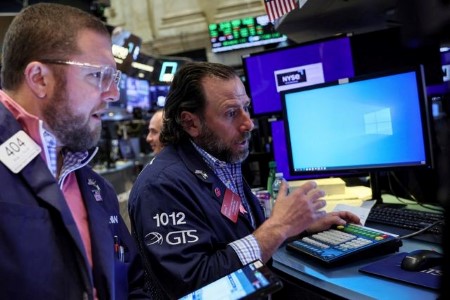May 9 (Reuters) – PacWest Bancorp shares (PACW) regained earlier session losses on Tuesday as investor uncertainty about the financial health of US regional banks underpinned skittish trading in their stocks.
PacWest rose 2.3% after losing as much as 10% earlier in the day following a decision by the Los Angeles-based lender to cut its quarterly dividend in an effort to bolster its liquidity.
The bank’s stock has rallied by more than 92% in the last three sessions after a bruising sell-off sent it to a record low last week.
“We believe that PacWest and other banks have not been trading in line with their fundamentals,” said Piper Sandler analyst Matthew Clark, who currently has an “overweight” rating on PacWest shares.
The shares of other regional banks were also choppy. Western Alliance (WAL) fell 1.4%, Valley National Bancorp (VLY) lost 1.5%, First Horizon Corp (FHN) shed 1.3%, and Synovus Financial Corp (SNV) dropped nearly 1%. But Comerica Inc (CMA) and Zion Bancorp (ZION) were up 0.39% and 0.66%, respectively.
The KBW Regional Banking Index dropped 0.72% on Tuesday and was hovering near its 30-month low hit last week after the collapse of First Republic Bank and PacWest’s decision to explore strategic options.
“Volatility is back. We had hoped that a resolution of (First Republic) would bring some calm and cooler heads back to the market. Instead, it seemed only to re-intensify wild price swings,” Piper Sandler analysts, led by Scott Siefers, wrote in a note to investors.
New York Federal Reserve President John Williams on Tuesday said the US banking system remained sound and resilient, and that the acute phase of the ongoing crisis was likely over, with problems limited only to a few banks.
Williams also said Fed was eyeing an end to the rate-hike cycle as inflation pressures have eased a bit and tighter financial conditions tied to banking sector troubles were expected to help further cool the economy.
PacWest and Western Alliance, which have been at the heart of the recent sell-off in regional banks, saw the steepest drop in deposits in the first quarter after First Republic Bank, according to S&P Global Market Intelligence data.
Analysts have called on the Federal Deposit Insurance Corp (FDIC), which currently insures USD 250,000 in deposits per person per bank, to raise its deposit coverage to end the current crisis with regional banks. The FDIC released a report last week, saying it saw merits in increasing the backstop for business accounts.
“The FDIC needs to raise its limits because that’s what will going to instill confidence in people and stop them from moving their money to larger banks,” said Michael Ashley Schulman, chief investment officer at Running Point Capital in California. “Otherwise smaller banks will be destroyed.”
(Reporting by Medha Singh and Vansh Agarwal in Bengaluru and Chibuike Oguh in New York, additional reporting by Bansari Mayur Kamdar; Editing by Arun Koyyur, Subhranshu Sahu and Jamie Freed)







 DOWNLOAD
DOWNLOAD






